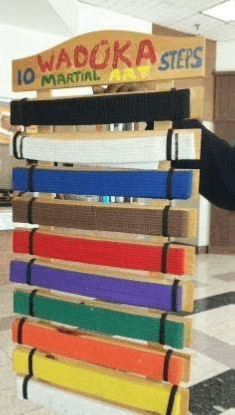HOW IT WORKS
10 Step Colour Coded Process
The Wadoka System is a 10-step 'colour-coded'
process that the student commits to in order to achieve a ‘black belt’ status.
This is crucial as it provides a very detailed introduction to the preliminary Katas. This sets
the stage to provide a novel and user-friendly approach to the katas that have to be
understood and performed in the later stages of the process.
Fees & What is Included in the Wadoka Program:
$1500.00 (All Applicable Taxes Included)
Program Includes:
(a) Complete Training System
(b) Custom-Designed Wadoka Karate Uniform
(c) 10 colour-coded belts
(d) Black Belt Certification/Certificate
(e) Shipping Costs (Uniforms, Belts, Certificates).

The Wadoka Karate Program Details & How it Works
- To get through the system, students need to achieve a passing grade of 70% in each of 10 Katas.
- The student starts with the “24-Kata”. This is a micro-system consisting of five (5) "mini-Katas."
- The sole purpose of the Kata is to set up a foundation for learning the other Katas and motivate (new) students to stay with the program.
- What we did was break down a complete Kata into 24 individual “pieces” (“moves”) which we further parceled out into “chunks” of nine (9), eight (8) and seven (7) “moves.”
- We refer to this technique as the “dim sum” method of learning. It fuels motivation. The student easily digests these “chunks” and is eager to be presented with something more challenging, like doing what we call “combinations.”
- The dim sum method allows for proper pacing or ‘pauses’- students can sometimes combine three individual moves into a single move.
- At this stage, the entire “chunk” system transforms into eleven (11) “combination moves.” This stage is very critical in terms of “getting to know” the Kata because it is designed to get students to ingest the Kata with a more ‘rhythmic’ quality which produces a demeanor of effortless grace when the student reaches the final stage of performing the complete Kata.
*$125.00-Optional (15-minute consultation with the Sensei at student's request)
Introducing the KATA – Sensei Colin Explains Its Power & Foundational Value to Karate
KATA is a routine of patterned movements meant to be practiced alone, whose sole purpose is to reproduce a series of prearranged techniques or “movements” which have been designed to deter and/or overcome an attacker. There is a long-standing debate about the value of the Kata among martial artists and others. Many karate fighters regard the Katas as essentially ‘useless’ in preparing for combat. Others see the routines as an important ‘foundation’ from which to launch more creative forms of attacking and/or defensive techniques. I am ashamed now to admit that when I first started karate training I found katas excruciatingly ‘boring’. But much later, when I had retired from competitive kumite (fighting) I was able to discover the true value of katas.
Know the True Value of KATAS | Moving Meditation
C.W. Nichols, in his book “Moving Zen” gave me the material to come up with the best definition of Katas. To me Kata is “moving meditation.” In fact, truly speaking it is when you attempt to overcome the ‘boredom’ of the movements, during that intense struggle with your “self’, that you begin to access a different sense of “space” and “time”. I am happy to confess now that for about 30 years (today) my primary mode of karate (and ‘personal’) training has been repeating ceaselessly an entire system of (roughly 10 different) katas on a daily basis.
Why? After spending many years as a successful kumite competitor in Canada I thought that once I made the Canadian Team to represent Canada in the “World Wado Ryu karate Championships” in, Tokyo, Japan, I would feel different. I did not. As happened in the many other tournaments that I attended, and won, I felt a feeling of “emptiness.’ I tell everyone now that if I hadn’t taken up the challenge of discovering the beauty and efficacy of the kata, to my extreme detriment, I would have given up karate a long time ago. But it wasn’t easy.
A Zen Moment Leads Sensei Colin to Appreciate the Importance of KATAS
Notwithstanding the thoughts I just expressed about Kumite, one encounters “Zen moments” in that place too. I remember one such incident. It occurred at a Shuri-te karate tournament in Toronto sometime in the 1990s. I was up against a tough fighter from Bellville, Ontario. As soon as we met I knew he had prepared to deal with me. I could tell by the look in his eyes. He knew that I liked to get close, feint to draw the opponent in attacking mode then use my accurate sense of timing to score. So he waited for me to come in. But from a distance of several feel away, accompanied by a great Ki (the so-called karate “yell”), I launched myself airborne closed the distance and scored a perfect Mawashigeri (round-house kick) to the midsection of his body.
I still remember the look of shock on his face along with a slight gesture of acknowledgement that he was taking full responsibility for the manner in which he had been outmaneuvered.
Don’t ask me how I managed to do what I did, because I don’t know. It was a totally intuitive decision made on the ‘spur of the moment’, which is why it worked. As a competitor, one gets addicted to these moments, even though they do not last very long. I would hazard an opinion that most great or, even so, good fighters simply ‘disappear’ after their tournament days are over. In this light, kata, metaphorically speaking, is considered a “civil(ian)” activity. Which is why, at first, it was difficult for me to transition to the repetitive drills that centre kata training.
KATA – The Soul of Karate
But I stayed with it and came to the realization that kata is actually the “soul of karate.” Where I differ, however, is that I tend to approach so-called “spiritual” matters through the lens of what I call “orthodox pragmatism.” Do good things and good things will ‘do you’ in return. This is my motto. There is really no need to look any further. I was really perplexed when I learned that the leader of our 5-man karate team, a 5th Degree black belt from British Columbia (Canada), had ‘retired’ from Karate soon after we returned from the world championships. The explanation given was that Karate began to conflict seriously with his ‘Christian beliefs’. I believe there exists a supreme spirit which some refer to as G-D, Yahweh, Allah, and the like. Christians, if I’m not mistaken, believe that their “Jesus is God.” I believe too that there are certain fundamental spiritual and/or religious practices and training that seekers of a certain ilk dedicate themselves to because they believe their sacrifices will produce no-less-than miraculous payoffs. But I do not believe that this holds for traditional karate training. We do incredible things because our training gives us the code to access well-stocked energy centers. In other words, karate training per se will not get you closer to God. But it will give you the skills and tools to stay the course.
Karate, the KATA & Spiritual Growth
My most joyous and rewarding classes I can recall was when I taught Karate to Orthodox Islamic students and held karate classes at Orthodox Jewish and Christian schools. They say ‘prayer’, we say ‘meditation’. One supposedly gets you closer to God. The other allows you to access a ‘Higher level of Consciousness’. I can recall debating a rabbi about the merits of “bowing”. He felt the gesture was sacrilegious because we would be ‘submitting’ to ‘idol worship’. I explained to him that we do it as a gesture of ‘respect’, ‘greeting’, even as an ‘apology’ and the debate ended. He got the point. In my mind it was purely a secular act, meant to help us get along well with each other. I still cringe when I encounter various narratives or so-called ‘quotes’ whose sole attempt is to 'spiritualize' martial arts. During and after my training I experience many things that have little to do with spiritual matters, like, for instance, finding a strategy to resolve the argument with my wife. Many of my business decisions too, came to me post-kata training.
Transforming the Art of KUMITE (Fighting) to the Art of LIVING
Just after he was born, my eldest son’s name ‘came to me’ during one of these sessions. Why? These “gifts” constitute the natural rewards that emerge from a system of training. I am convinced that the potent quality of the Kata’s micro-sequences aligned with the focus it takes to deliver them creates a sort of ‘psychic code’ which provides access to both superficial and submerged ‘energy-fields’ that make up the person’s cognitive apparatus. The World Karate Federation (WKF) made it clear that “Kata must demonstrate strength, power, speed, grace, rhythm and balance.” These have been the key attributes I took to transform the art of kumite (fighting) to the “art of living.”
